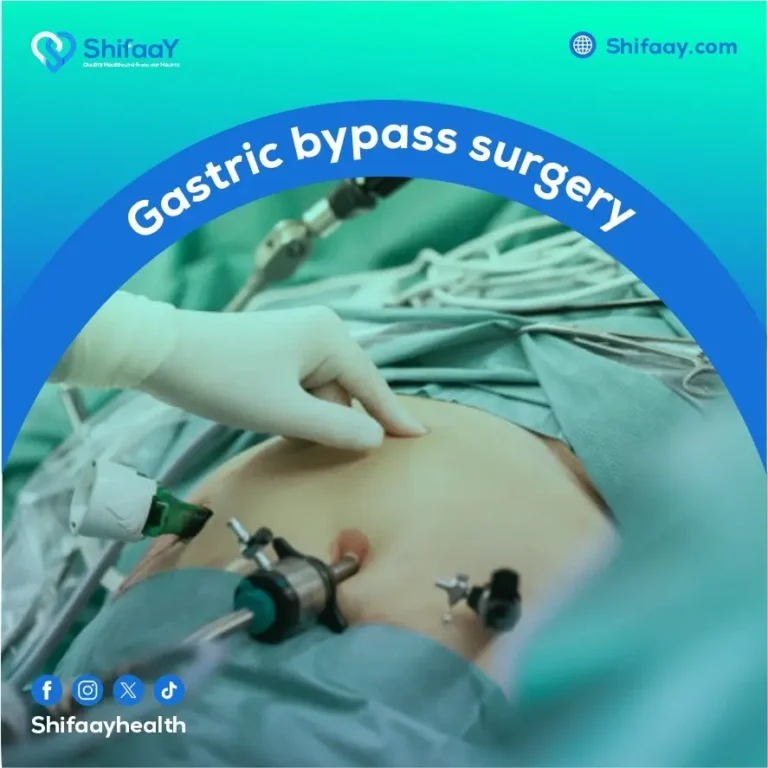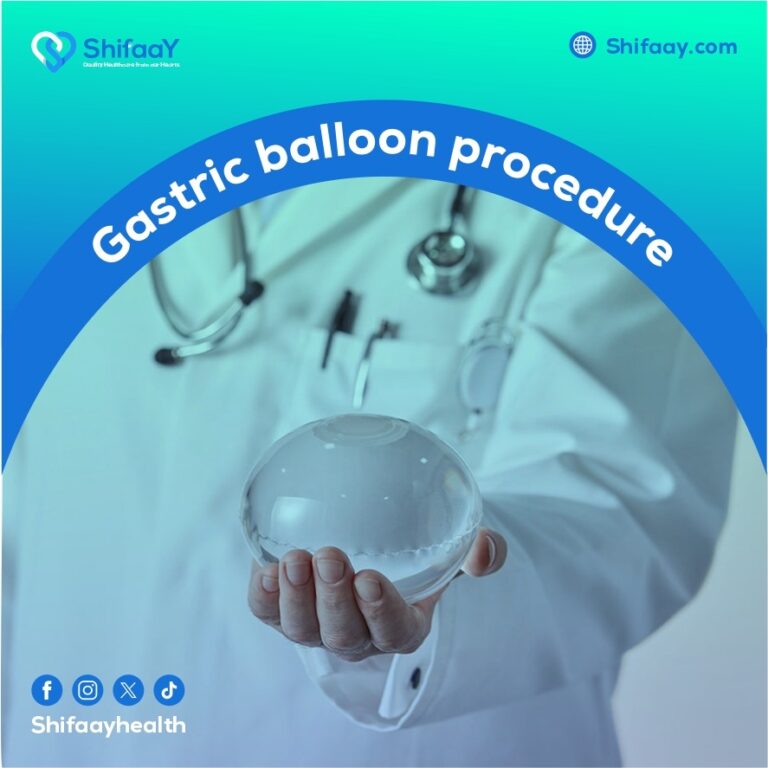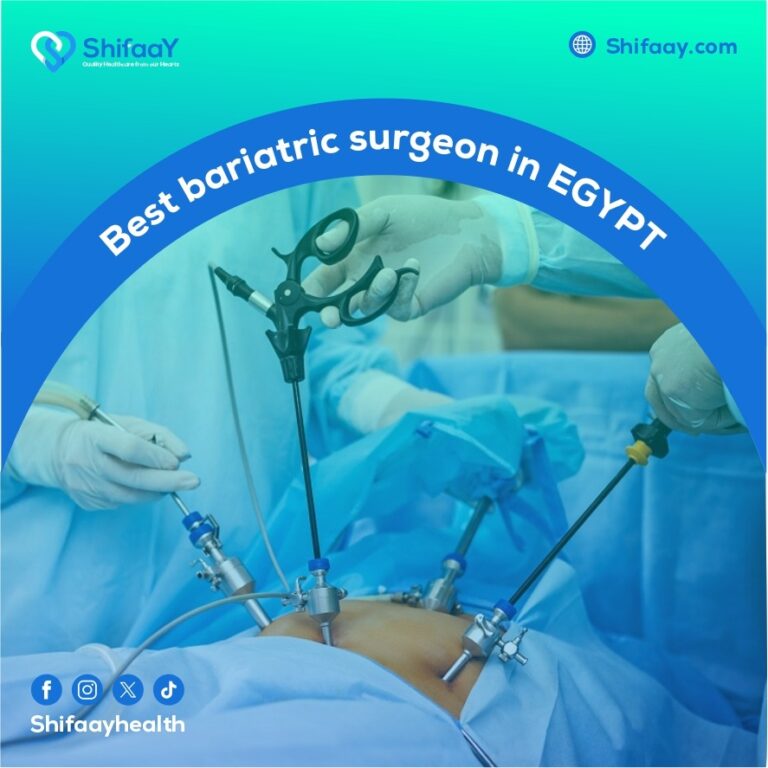What is Gastric Stapling Surgery?
There’s no doubt that gastric stapling surgery is one of the most transformative medical procedures that has helped change the lives of many individuals seeking effective medical solutions to treat morbid obesity. But have you ever imagined how this procedure could completely change your lifestyle?
The answer is simple: it lies in the radical transformations that occur in both the body and the mind after the operation. By reducing the size of the stomach, the amount of food consumed becomes significantly smaller, leading to gradual and safe weight loss. This change doesn’t only affect the external appearance—it also has a positive impact on both physical and mental health. Patients often report increased energy levels and relief from issues such as joint pain, sleep disorders, and breathing problems. Gastric stapling surgery can thus be a powerful starting point toward a more balanced and high-quality life.
Gastric stapling is recognized as an effective medical procedure in which the stomach size is reduced using special surgical staples. This limits the amount of food a person can consume and increases the feeling of fullness more quickly. It’s considered a highly suitable option for individuals who haven’t had success with traditional weight loss methods—particularly those suffering from health complications due to morbid obesity, such as high blood pressure or diabetes.
The procedure is usually performed laparoscopically, which makes it less risky and offers a quicker recovery compared to traditional open surgeries. The results are often noticeable within just a few months after the operation.
Making the decision to undergo gastric stapling surgery is not easy, but it may be one of the most important decisions in a patient’s life. That’s why Shifaay Healthcare Center is committed to providing all the necessary support and information for patients—from accurate health assessments and thorough explanation of the procedure and potential risks, to close follow-up after surgery.
The center may also include a select team of bariatric surgery specialists and a highly qualified medical team to ensure the highest levels of safety and care throughout the treatment journey. Additionally, Shifaay is dedicated to offering a comprehensive post-operative rehabilitation program, including nutritional follow-up, psychological support, and physical guidance to help patients achieve optimal health outcomes.
Laparoscopic Gastric Stapling Surgery
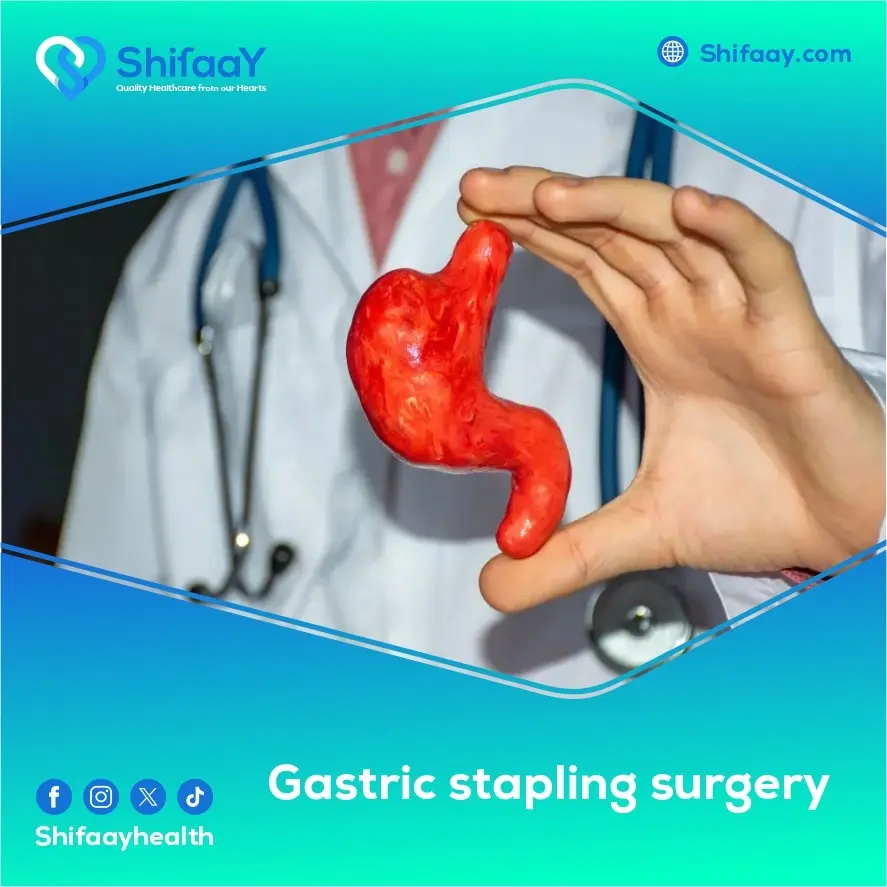
Laparoscopic gastric stapling surgery has become one of the most effective surgical solutions that has helped many individuals achieve their dream of fitness and eliminate morbid obesity in a safer, more effective, and modern way.
If you suffer from excessive weight gain and are looking for an effective way to transform your lifestyle for the better, Shifaay Healthcare Center offers a comprehensive treatment experience—from accurate diagnosis to ongoing post-surgery follow-up—ensuring the best health and aesthetic outcomes.
The center is committed to delivering the highest standards of healthcare through a medical team specialized in bariatric surgery with extensive experience in performing laparoscopic gastric stapling using the latest technologies and advanced medical equipment.
This laparoscopic technique works by reducing the stomach size using precise medical instruments that are inserted through small incisions in the abdomen. As a result, food intake is significantly limited, leading to gradual and safe weight loss.
Compared to open surgeries, this technique is associated with fewer complications, faster recovery, and much less pain—making it a preferred option for both patients and doctors.
What sets Shifaay Healthcare Center apart is not only its extensive medical expertise but also its personalized care for each patient. The center offers a complete follow-up program post-surgery, including nutritional and psychological support and regular evaluations of actual results.
Additionally, the center is committed to patient education, providing all necessary information about maintaining a healthy lifestyle after surgery to ensure long-term positive results.
Special attention is also given to quality of life after the procedure, and every treatment plan is designed to meet the patient’s individual needs and medical condition. A supportive and motivating environment is provided to encourage success and achieve the desired health transformation—making Shifaay the ideal choice for many.
Read aslo: Gastric Bypass Surgery
Non-Surgical Gastric Stapling
Non-surgical gastric stapling has today become a dream come true for many individuals seeking to lose weight without undergoing complex and daunting surgical procedures. Thanks to Shifaay Medical Center, one of the leading pioneers in offering this type of modern medical solution, patients now have access to a safe and comfortable therapeutic environment. The center boasts a specialized medical team proficient in utilizing the latest endoscopic techniques to reduce stomach size non-surgically. This method naturally helps decrease appetite and food intake, while also allowing patients to quickly resume their normal lives without needing extended recovery time. Additionally, it significantly reduces the risk of potential complications, making the weight loss journey easier and safer.
Relying on the non-surgical gastric stapling technique gives you the ideal opportunity to shrink your stomach size through a non-invasive, endoscopic procedure. This approach typically limits food consumption and promotes a faster and longer-lasting feeling of fullness. The procedure is usually completed in a very short time, allowing you to return home on the same day without long recovery periods or the concerns associated with traditional surgery. It is also an ideal option for individuals who cannot undergo surgery for health or personal reasons, as it combines medical effectiveness with psychological comfort. Moreover, it often helps achieve noticeable weight loss results when the patient adheres to the doctor’s instructions and follows the prescribed diet.
At Shifaay Healthcare Center, we not only provide effective medical solutions but also accompany you on a holistic journey toward a better, more balanced life. Our specialized team of doctors and consultants ensures precise follow-up after the procedure, along with nutritional and psychological support to help achieve long-term results. We are committed to offering a comprehensive follow-up program, which includes regular visits to assess your health status, adjust your diet, and provide guidance to help maintain an ideal weight over time. This ensures sustainable results and healthy balance in your life.
The Difference Between Gastric Stapling and Gastric Sleeve Surgery
Surgical procedures to treat morbid obesity are among the most effective medical solutions sought by many individuals struggling with excessive weight. Among these procedures, gastric stapling surgery and gastric sleeve surgery stand out as two main options that help patients reduce weight and achieve significant health improvements. Although both aim to reduce stomach size and decrease appetite, there are fundamental differences between them in terms of the procedure type, benefits, and associated risks. Below, we explore the differences between gastric stapling and gastric sleeve surgery:
First: Gastric Sleeve Surgery
Gastric sleeve surgery is one of the most common surgical procedures for treating morbid obesity. It aims to permanently reduce the size of the stomach by removing a large portion—approximately 75–80%—which significantly limits the amount of food a patient can consume.
One of the major advantages of this procedure is its ability to reduce the secretion of ghrelin, the “hunger hormone,” which greatly decreases appetite. In addition, it helps improve many obesity-related health conditions, such as diabetes and high blood pressure, by promoting effective weight loss. On the other hand, this procedure typically requires a longer recovery period compared to other options.
Second: Gastric Stapling Surgery
Gastric stapling is a surgical procedure in which special staples are used to divide the stomach into two sections, effectively reducing its size without removing any part of it. The remaining isolated part of the stomach remains in the body but does not participate in digestion.
The primary goal of gastric stapling surgery is to limit the amount of food a patient can eat per meal, thus reducing overall calorie intake.
This procedure is less complex than gastric sleeve surgery in terms of operation time and recovery period. However, it does not significantly affect hunger hormone secretion or nutrient absorption.
Read aslo: Treatment of Femoral Head Erosion
Cost of Gastric Stapling Surgery in Egypt
It is important to note that gastric stapling surgery is one of the oldest bariatric procedures aimed at effective and sustainable weight loss. Today, it has become the preferred option for many individuals suffering from morbid obesity, especially after failing to achieve tangible results through traditional diets and exercise.
The concept of gastric stapling surgery in Egypt is based on reducing the size of the stomach using advanced medical tools, with the goal of decreasing the amount of food consumed, leading to early satiety. This helps patients gradually and safely lose weight, making the procedure a real turning point in the lives of those affected by the physical and psychological consequences of obesity.
Gastric bypass surgery offers several advantages that make it a suitable option for many patients. Most notably, it does not require the removal of any part of the stomach, as is the case with sleeve gastrectomy, which makes it a less invasive procedure. Additionally, it is usually performed laparoscopically, reducing recovery time and the risk of complications. Furthermore, it often leads to significant weight loss within the first few months after surgery—especially when patients adhere to postoperative dietary guidelines.
The cost of gastric stapling surgery in Egypt varies from one medical center to another, generally ranging between EGP 35,000 and EGP 45,000. This price variation is attributed to several key factors, including the level of facility equipment, the surgeon’s expertise, additional services such as comprehensive preoperative medical tests, customized postoperative diet plans, and the pricing policy of the medical institution. Therefore, it is advisable to choose a specialized and reputable medical center like Shifaay to ensure optimal results and minimize the risk of complications.
Long-Term Complications of Gastric Stapling
Gastric stapling surgery is one of the most common surgical procedures for treating morbid obesity, and Egypt has become a top destination for such surgeries due to significantly lower costs compared to other countries. However, this low cost may conceal real risks. Some patients may opt for non-specialized doctors or under-equipped medical centers in an attempt to save money, unaware that such decisions could lead to serious short- and long-term health consequences.
One of the most prominent complications that may arise when the procedure is performed by an unqualified surgeon is infection, which can cause severe pain and lead to more serious complications if not promptly treated. Patients may also develop pneumonia due to poor postoperative care during the recovery period, and respiratory problems can occur as a result of anesthesia or limited mobility after the surgery. These complications are not only related to the surgery itself but also to the competence of the surgical team and the readiness of the healthcare facility.
One of the most dangerous potential issues following gastric stapling is gastric leakage, where digestive fluids escape from the gastrointestinal tract into the abdominal cavity, causing severe infections that can be life-threatening. Severe internal bleeding is another possible complication, especially if not controlled in a timely manner. For these reasons, relying on Shifaay, recognized as the best medical tourism center in Egypt, is not a luxury but a medical necessity to minimize these risks and ensure a safe and successful recovery.
Advantages and Disadvantages of Gastric Stapling Surgery
Amid the variety of medical and surgical options available for treating morbid obesity, gastric stapling surgery remains one of the most well-known and widely performed procedures among patients seeking a radical solution to excess weight. Despite the emergence of many modern and diverse techniques, many individuals with obesity continue to opt for this procedure due to its tangible benefits. Below, we outline the most important advantages and disadvantages of gastric stapling surgery:
First: Advantages of Gastric Stapling Surgery
The procedure helps patients lose approximately 50% of their excess weight within the first year.
It is characterized by a short recovery period, often requiring no more than one night in the hospital.
Patients can typically resume their normal daily activities within just three weeks.
The staples can be removed, and the stomach can be returned to its original size relatively easily if necessary.
The cost of the procedure in Egypt is considered affordable and accessible to a wide segment of the population compared to some other surgical options.
Second: Disadvantages of Gastric Stapling Surgery
The patient may experience some pain or discomfort in the abdominal area after the procedure.
The reduction in stomach size may lead to a decrease in appetite.
Due to the loss of essential nutrients, the patient may feel fatigued and exhausted during the initial period post-surgery, necessitating regular medical follow-up and the use of dietary supplements.
Patients’ Experiences with Gastric Stapling Surgery
Patients’ experiences with gastric stapling surgery reveal many hidden aspects that are often not mentioned in medical ads or promotional materials. Between the hope for weight loss and the fear of complications, patients undergo a realistic journey worth listening to.
Some achieved remarkable and ideal weight loss results, with significant improvement in their general health—conditions like diabetes and hypertension disappeared, and their quality of life and self-confidence improved dramatically.
On the other hand, some faced difficult challenges, such as leakage, persistent nausea, and psychological difficulties due to the dramatic lifestyle and dietary changes.
Many patients describe this surgery as the true beginning of a new life. After years of failed attempts with diets and physical activity, the surgery came as one of the most effective tools that helped them control their hunger, increase satiety, and achieve rapid weight loss without constant struggle.
One patient shares their story, saying:
“At Shifaay Center, I never felt like just a patient—I was a partner in my treatment decision. I found people who truly understood and guided me. That reflects the quality of service and attention to the smallest details before the big ones.”
Nonetheless, patients’ journeys may include psychological or physical challenges, especially during the first few weeks after surgery. However, with the comprehensive medical team provided by Shifaay Center, patients can overcome this stage with confidence and reassurance, ensuring a healthier and happier life.
Success Rate of Gastric Stapling Surgery
The success rate of gastric stapling surgery is one of the primary factors that motivates many patients to undergo this type of surgical procedure—especially those suffering from morbid obesity and looking for long-term medical solutions.
Thanks to high success rates and patient satisfaction with results, the surgery is seen as an attractive option for weight reduction and improving quality of life. It also helps reduce the risk of chronic diseases associated with obesity, such as diabetes, hypertension, and heart problems.
Recent studies indicate that the success rate of gastric stapling surgery ranges from 80% to 90%, reflecting advancements in surgical techniques, physician expertise, and the body’s response to such procedures. Success in this surgery isn’t limited to just weight loss—it also includes significant improvement in obesity-related conditions like type 2 diabetes, hypertension, and sleep apnea.
Since deciding to undergo gastric stapling surgery is not an easy choice, at Shifaay Center, we are committed to providing comprehensive and accurate medical consultations to help patients make the right decision based on their individual health status. We believe that the success of the procedure begins with thorough initial evaluation, continues through psychological and physical preparation, and ends with meticulous post-operative follow-up to ensure the best possible results.
That’s why we offer a specialized medical team in bariatric surgeries, supported by the latest technologies and global standards, to maintain positive outcomes in the long run.
Necessary Preparations Before Gastric Stapling Surgery
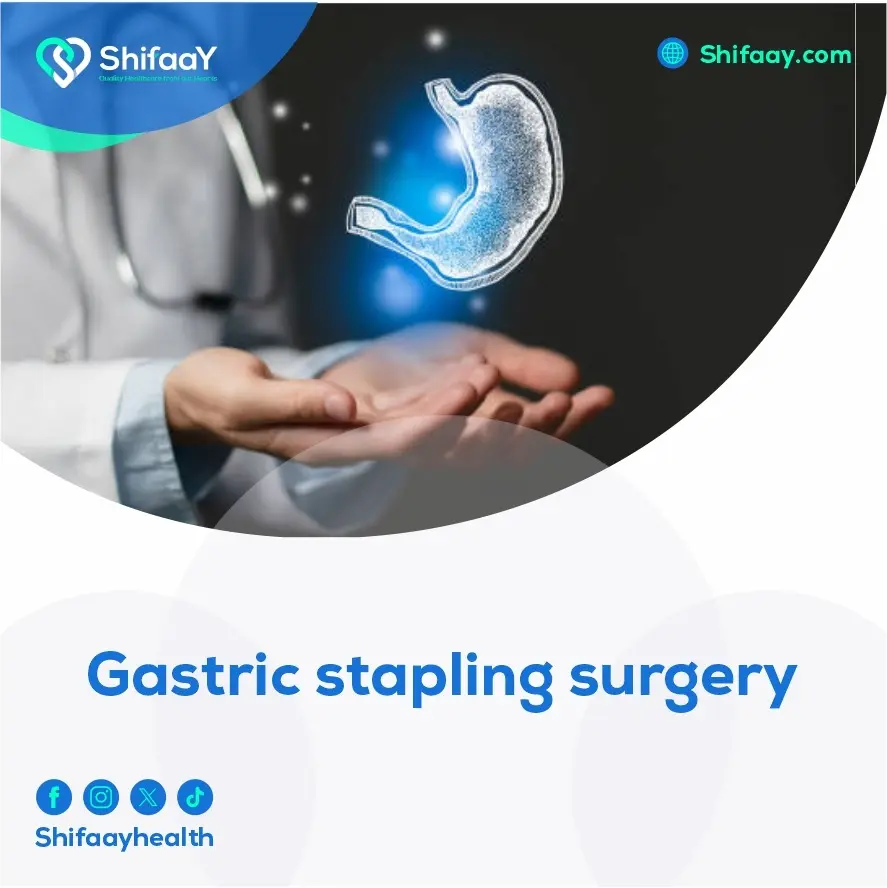
The necessary preparations before gastric stapling surgery represent one of the most critical phases that can ensure the procedure’s success and the safe achievement of the desired results. What many may not realize is that the psychological and physical readiness for this step can have a greater impact than the surgery itself. Below are the most important preparations you should be aware of:
The journey begins with a visit to the specialist to ensure your body is suitable for the surgery. This includes performing blood tests, cardiac evaluations, liver function tests, and other relevant investigations.
Undergoing psychological and nutritional assessments is essential to confirm your ability to commit to the new lifestyle post-surgery.
It is recommended to stop smoking and alcohol consumption for at least two weeks before the operation to reduce the risks associated with anesthesia and possible complications.
You may be asked to lose some weight prior to the procedure by following a low-calorie diet. This helps shrink the liver size and makes the surgery technically easier.
Certain medications, such as blood thinners, must be discontinued several days before the operation, as per the instructions of the best bariatric surgeon in Egypt.
Motivating yourself and receiving support from family or a psychological professional is crucial to help you overcome the challenges that may arise after the surgery.
Read aslo: What is the Gastric Balloon Procedure?
Is Gastric Stapling Surgery Still Performed Today?
Gastric stapling surgery is rarely performed nowadays, as it has largely been replaced by more effective and safer procedures such as gastric sleeve surgery and gastric bypass. The decline in its use is due to its numerous complications, the difficulty of making modifications later on, and the limited long-term weight loss outcomes compared to modern options.
What Is the Difference Between Gastric Stapling and Gastric Sleeve Surgery?
The main difference between gastric stapling surgery and gastric sleeve surgery lies in the technique. Gastric stapling involves using specialized staples to partition the stomach without removing any part of it, thereby reducing its volume. In contrast, gastric sleeve surgery involves the surgical removal of about 80% of the stomach, which not only reduces appetite but also affects hunger-related hormones.
Is Gastric Stapling Surgery Dangerous?
The risks associated with gastric stapling surgery include the potential for developing blood clots in the leg veins or lungs, in addition to the possibility of respiratory difficulties or pneumonia after the operation. In some cases, the patient may also face the risk of bleeding during the procedure, which necessitates close medical monitoring.
How Long Does Gastric Stapling Surgery Take?
Gastric stapling surgery typically takes between one to two hours and is performed laparoscopically under general anesthesia. The recovery period usually lasts for one to two days, and patients can gradually resume their regular activities within a week, provided they strictly adhere to the post-operative dietary regimen to ensure success.

